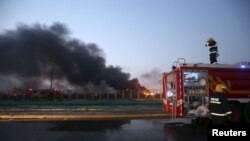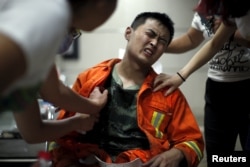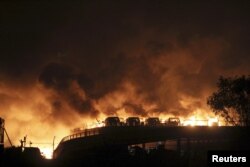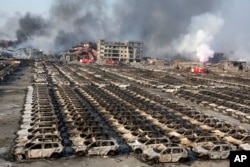As Chinese authorities continue investigating the causes of massive explosions in the northeastern city of Tianjin, they are also scrutinizing the city’s firefighting operations and port safety.
The two gigantic blasts, which occurred late Wednesday near a warehouse storing hazardous chemicals in the city’s industrial neighborhood, killed at least 50 people and injured 700 others.
The casualties include the first batch of more than 30 firefighters, a dozen of whom rushed in to put out a fire. Many are now dead or missing.
Some experts say that those firefighters, who had little clue of what had caused the flames while battling the blaze, may have made things worse by spraying water on hazardous chemicals and triggering explosions.
The warehouse was storing mainly ammonium nitrate, a highly combustible chemical used in explosives, and potassium and calcium carbide, among other hazardous chemicals, according to police.
“Calcium carbide will react with water to create acetylene. Basically, it [acetylene] can be easily ignited by any source of fire. If the quantity is large enough, a huge explosion may be triggered,” said Biing-jiun Uang, professor of chemistry at National Tsing Hua University.
Such a massive blaze, triggered by explosive chemicals, is beyond the capabilities of many fire rescuers. Hao-giang Tay, deputy president of the Malaysia branch of the Institution of Fire Engineers, said those first responders should not have be left alone in the first place to deal with the blasts.
“They [firefighters] are actually trying to deal with fire. Bombs, explosions are supposed to be dealt with by the bomb squad, special bomb squads either from the police or from the military,” said Tay.
A team of 217 military, nuclear and biochemical specialists, along with a group from the International Atomic Energy Agency’s Beijing office, have reportedly been dispatched to the site, according to the official Xinhua news agency.
Port safety
Concerns have also been raised about the issue of port safety as Tianjin will be the port for the massive metropolis planned around Beijing.
The blasts on Wednesday have made many question why a facility storing such large quantities of volatile chemicals had not been housed in a more isolated area.
“The planning department should be looking at that and say let’s get a separation. There must be a buffer zone. If they were built very much farther away, then, of course, you know, the damage will be contained within the incident place,” says Tay of the Institution of Fire Engineers in Malaysia.
At a press conference on Friday, authorities said that Ruihai International, the company at the center of the disaster, received approval to renovate its warehouse in late 2012 so that it could be used as a temporary storage facility for hazardous materials.
Officials also have said that the massive destruction brought on by the blast is frustrating investigations. They said conflicting information from company managers and customs authorities is also making it difficult to identify just what chemicals and hazardous materials were in the warehouse when the blast occurred. Officials have said that on average the warehouse had about 50,000 tons of dangerous materials.
China Dialogue, a bilingual website in Chinese and English that focuses on environmental issues, said that in 2013 the Tianjin Academy of Environmental Protection Sciences conducted an environmental impact assessment of the warehouse. The review highlighted the dangers materials there posed, but added that the risk of any accident occurring was within acceptable limits.
The report also said that in response to 130 questionnaires, 100 percent agree the site was suitable and 52 percent felt the warehouse's environmental protection measures were sufficient.
The report did not say who responded to the questionnaires, and now in light of what has happened, many are likely to be asking just how and why the environmental impact assessment was approved.











